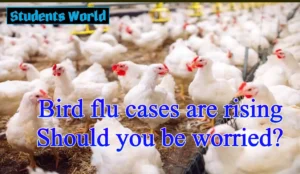Bird flu cases are rising Should you be worried?
 1. What is Bird Flu (Avian Influenza)?
1. What is Bird Flu (Avian Influenza)?
Caused by influenza type A viruses primarily affecting birds. Notable strains: H5N1, H7N9, H5N8. Zoonotic in nature – can infect humans under certain conditions.
2. Recent Rise in Cases
WHO and national health agencies have reported a spike in bird flu cases in poultry and wild birds. Some rare human infections have also been recorded, raising concerns.
3. Transmission to Humans
Direct contact with infected birds (live or dead), their droppings, or contaminated environments. Human-to-human transmission is extremely rare but under surveillance for mutations.
4. Public Health Risk
Low immediate risk to general public. High-risk groups: poultry workers, veterinarians, and people in close contact with birds. Potential for future pandemic if virus mutates for efficient human transmission.
5. Economic & Agricultural Impact
Mass culling of poultry affects farmers and food industry. Trade restrictions on poultry products can hurt exports.
6. Government Measures
Surveillance and rapid response teams under Integrated Disease Surveillance Programme (IDSP). Culling and disinfection in affected areas. Awareness campaigns and biosecurity measures in poultry farms.
7. Global Monitoring
Coordinated by WHO, FAO, and OIE. India participates in global avian influenza surveillance programs.
8. Precautionary Measures for Citizens
Avoid contact with sick or dead birds. Ensure proper cooking of poultry and eggs. Follow advisories issued by health departments.
9. Should You Be Worrie?
Currently, No, but stay vigilant. Risk is limited but potential exists if virus mutates. Preparedness and awareness are key.
10. Way Forward
Strengthen “One Health” approach integrating human, animal, and environmental health.Enhance early detection, vaccination research, and international collaboration